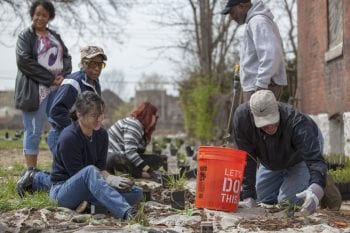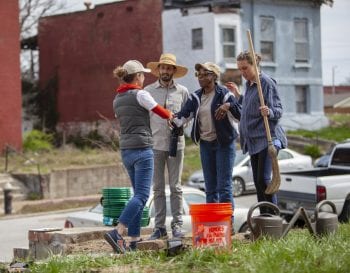The Enright Community Butterfly Garden envisions a new kind of socially and ecologically engaged public space for the Enright neighborhood. The project’s collaborators are the neighbors of the Enright Block Unit, the Pulitzer Arts Foundation, and Micah Stanek, Lecturer in Landscape Architecture at WashU. The three groups are working side-by-side to create a beautiful, natural, low-maintenance space for community members to form relationships as they interact with nature and each other.
From its start, the Enright Community Butterfly Garden has belonged to the neighbors, who will take over management entirely by the end of 2018. Elvis Hopson and Richard Butler have been at the center of the development and design of the garden. They are residents who already mow vacant lots on the block and help care for elderly neighbors’ yards. Ola Fort, whose home is visible from the garden, is another neighbor who has been involved in every stage of the project’s planning and implementation. She discussed the issue of vacancy in her community and many others in the area. She pointed out a vacant house across the road, explaining the problems that vacancy causes for neighborhoods like Enright. The lot where the butterfly garden is being constructed used to hold a similarly vacant house.
The Pulitzer Arts Foundation worked with a German architecture collective on a project to deconstruct the house and create a partial reconstruction inside the Pulitzer building, asking questions and prompting thought about housing, demolition, vacancy, and its social implications. After the demolition, the Pulitzer Public Programs and Engagement team wanted the art project to generate funding for a follow-up community project, through the salvage and sale of materials from the building. The neighbors chose the butterfly garden as their new vision for the lot. The Pulitzer’s website states that over 7,000 buildings, mostly homes, “are currently designated as unsafe and fated for demolition” in the city of St. Louis. The butterfly garden is a way of reclaiming the vacant lot for the neighbors’ use.
Micah is the project’s landscape architect, and he has plans to graft a native oak savanna in the lot in order to maximize butterfly diversity. Micah sees the project as an opportunity to unite teaching, research, and community engagement. He has included a Community-Engaged Teaching component related to his partnership with Enright to his course, “Research in the Landscape: Methods and Practices,” noting that it “certainly takes an extra effort to teach in a civically engaged way.” Micah models the attitude of humility that he wants to teach his students, focusing first on what the community wants and taking the time to listen. Micah received a St. Louis Project Grant from the Civic Engagement Fund in order to continue implementing the neighbors’ vision. According to Micah, the project’s goals are “to consistently engage neighbors in design development and project implementation; to implement the garden, cultivating biodiversity and taking care to make places for people to comfortably dwell; to return brick elements from the house to commemorate the historic character of the neighborhood; and finally, to develop a replicable and adaptable land stewardship model for vacant lots in St. Louis.” Micah foresees the possibility of this pilot project being repeated in other communities through similar partnerships.
The project owes its success largely to its collaborative nature. Ola said, “The neighbors are really active participants. It makes a difference that they are the catalysts.” Both Micah and Sophie Lipman, who works for the Pulitzer, emphasized that the garden belongs first to the neighbors and the goal is to respond to what the neighbors want. “Collaborate, listen, be humble,” Sophie said.

